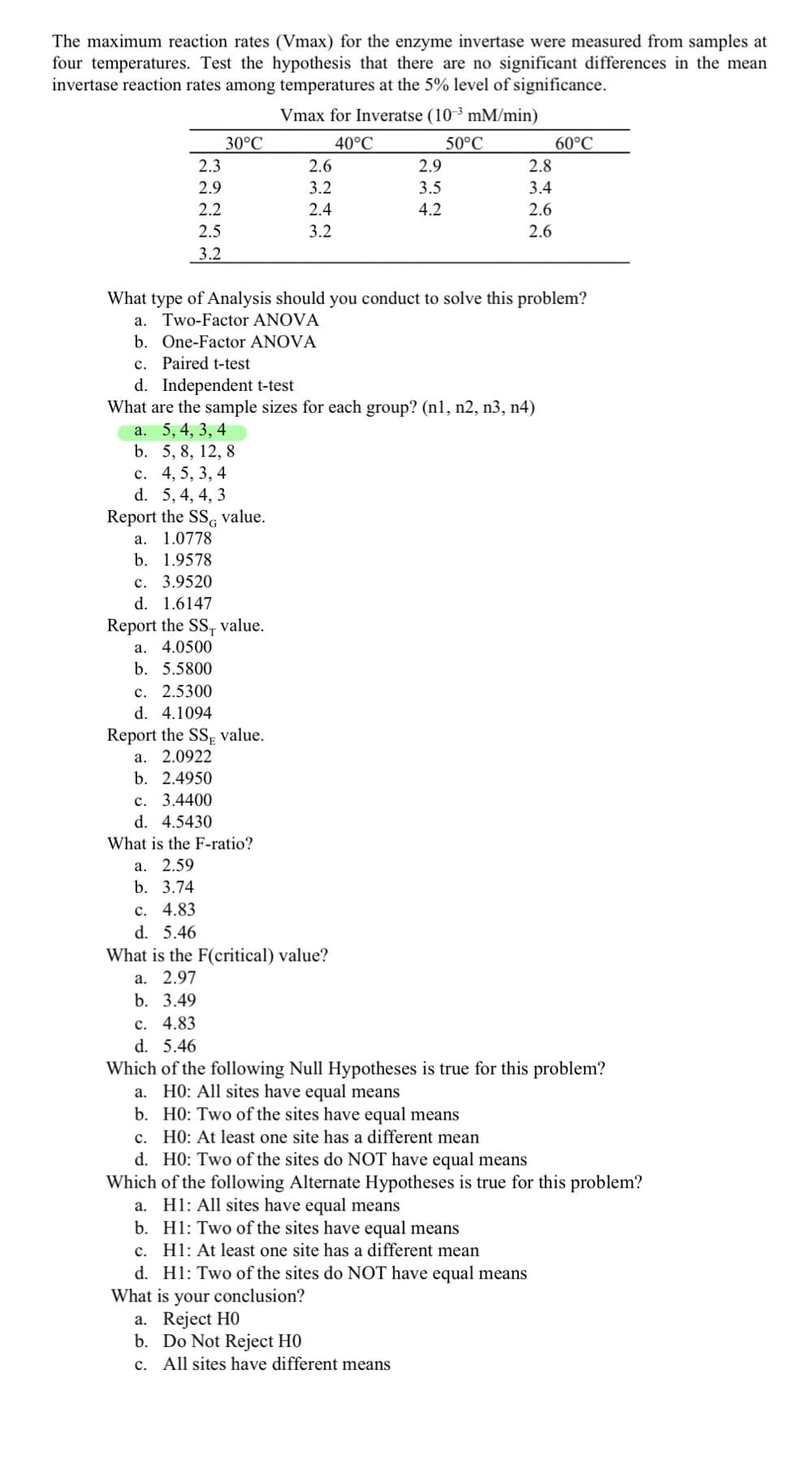The maximum reaction rates (Vmax) for the enzyme invertase were measured from samples at four temperatures. Test the hypothesis that there are no significant differences in the mean invertase reaction rates among temperatures at the 5% level of significance. Vmax for Inveratse (103 mM/min) 30°C 40°C 50°C 60°C 2.3 2.6 2.9 2.8 2.9 3.2 3.5 3.4 2.2 2.4 4.2 2.6 2.5 3.2 2.6 3.2 What type of Analysis should you conduct to solve this problem? a. Two-Factor ANOVA b. One-Factor ANOVA c. Paired t-test d. Independent t-test What are the sample sizes for each group? (n1, n2, n3, n4) а. 5, 4, 3, 4 b. 5, 8, 12, 8 c. 4, 5, 3, 4 d. 5, 4, 4, 3 Report the SSG value. a. 1.0778 b. 1.9578 c. 3.9520 d. 1.6147 Report the SS, value. a. 4.0500 b. 5.5800 c. 2.5300 d. 4.1094 Report the SSE value. a. 2.0922 b. 2.4950
The maximum reaction rates (Vmax) for the enzyme invertase were measured from samples at four temperatures. Test the hypothesis that there are no significant differences in the mean invertase reaction rates among temperatures at the 5% level of significance. Vmax for Inveratse (103 mM/min) 30°C 40°C 50°C 60°C 2.3 2.6 2.9 2.8 2.9 3.2 3.5 3.4 2.2 2.4 4.2 2.6 2.5 3.2 2.6 3.2 What type of Analysis should you conduct to solve this problem? a. Two-Factor ANOVA b. One-Factor ANOVA c. Paired t-test d. Independent t-test What are the sample sizes for each group? (n1, n2, n3, n4) а. 5, 4, 3, 4 b. 5, 8, 12, 8 c. 4, 5, 3, 4 d. 5, 4, 4, 3 Report the SSG value. a. 1.0778 b. 1.9578 c. 3.9520 d. 1.6147 Report the SS, value. a. 4.0500 b. 5.5800 c. 2.5300 d. 4.1094 Report the SSE value. a. 2.0922 b. 2.4950
Linear Algebra: A Modern Introduction
4th Edition
ISBN:9781285463247
Author:David Poole
Publisher:David Poole
Chapter4: Eigenvalues And Eigenvectors
Section4.6: Applications And The Perron-frobenius Theorem
Problem 25EQ
Related questions
Question
Need some help

Transcribed Image Text:The maximum reaction rates (Vmax) for the enzyme invertase were measured from samples at
four temperatures. Test the hypothesis that there are no significant differences in the mean
invertase reaction rates among temperatures at the 5% level of significance.
Vmax for Inveratse (10 ³ mM/min)
30°C
40°C
50°C
60°C
2.3
2.6
2.9
2.8
2.9
3.2
3.5
3.4
2.2
2.4
4.2
2.6
2.5
3.2
2.6
3.2
What type of Analysis should you conduct to solve this problem?
a. Two-Factor ANOVA
b. One-Factor ANOVA
c. Paired t-test
d. Independent t-test
What are the sample sizes for each group? (n1, n2, n3, n4)
a. 5, 4, 3, 4
b. 5, 8, 12, 8
c. 4, 5, 3, 4
d. 5, 4, 4, 3
Report the SSG value.
a. 1.0778
b. 1.9578
c. 3.9520
d. 1.6147
Report the SS, value.
4.0500
а.
b. 5.5800
c. 2.5300
d. 4.1094
Report the SSE value.
a. 2.0922
b. 2.4950
c. 3.4400
d. 4.5430
What is the F-ratio?
а. 2.59
b. 3.74
c. 4.83
d. 5.46
What is the F(critical) value?
a. 2.97
b. 3.49
c. 4.83
5.46
Which of the following Null Hypotheses is true for this problem?
a. HO: All sites have equal means
b. HO: Two of the sites have equal means
c. HO: At least one site has a different mean
d. HO: Two of the sites do NOT have equal means
Which of the following Alternate Hypotheses is true for this problem?
a. Hl: All sites have equal means
b. Hl: Two of the sites have equal means
c. H1: At least one site has a different mean
d. Hl: Two of the sites do NOT have equal means
What is your conclusion?
a. Reject HO
b. Do Not Reject HO
c. All sites have different means
Expert Solution
This question has been solved!
Explore an expertly crafted, step-by-step solution for a thorough understanding of key concepts.
This is a popular solution!
Trending now
This is a popular solution!
Step by step
Solved in 2 steps with 1 images

Knowledge Booster
Learn more about
Need a deep-dive on the concept behind this application? Look no further. Learn more about this topic, statistics and related others by exploring similar questions and additional content below.Recommended textbooks for you

Linear Algebra: A Modern Introduction
Algebra
ISBN:
9781285463247
Author:
David Poole
Publisher:
Cengage Learning

Linear Algebra: A Modern Introduction
Algebra
ISBN:
9781285463247
Author:
David Poole
Publisher:
Cengage Learning